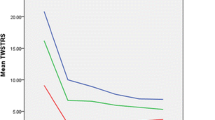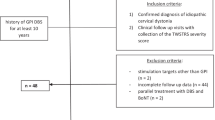Abstract
The globus pallidus internus (GPi) has been the primary target for deep brain stimulation (DBS) to treat severe medication–refractory dystonia. Some patients with primary cervical dystonia do not respond adequately to GPi stimulation. Subthalamic nucleus (STN) DBS may provide an alternative choice for treating this dystonia. In this study, we analysed the effect of bilateral STN DBS on two patients of medically refractory primary cervical dystonia. The severity of the dystonia was measured using the Toronto Western Spasmodic Torticollis Rating Scale (TWSTRS) preoperatively, and 1, 3, 6 and 12 months postoperatively and yearly follow-up was performed. Any change in mental status was recorded using the Mini-Mental State Examination (MMSE) score. Surgery was performed using the Leksell stereotactic system and by fusing CT scan and MR images with neuronavigation and microelectrode recording. Both patients were followed for more than 3 years. STN DBS was well-tolerated by both patients with no adverse effects. The benefit seems to be immediate. The first patient showed 74% improvement, and the second patient showed 84.3% improvement in the overall TWSTRS score. No mental deterioration was observed in either of the cases, as the MMSE score remained unchanged in both patients. A prior bilateral pallidal lesion in the first case did not adversely affect the outcome. This study showed that bilateral STN DBS results in a very significant improvement in cervical dystonia with no mental worsening and suggests that STN DBS may be an alternative to GPi DBS for treating primary cervical dystonia.


Similar content being viewed by others
Abbreviations
- CT:
-
Computerized axial tomography
- DBS:
-
Deep brain stimulation
- GPi:
-
Globus pallidus internus
- MMSE:
-
Mini-Mental State Examination
- MRI:
-
Magnetic resonance imaging
- STN:
-
Subthalamic nucleus
- TWSTRS:
-
Toronto Western Spasmodic Torticollis Rating Scale
References
Coubes P, Cif L, El Fertit H et al (2004) Electrical stimulation of globus pallidus internus in patients with primary generalized dystonia: long-term results. J Neurosurg 101:189–194
Kleiner-Fisman G, Liang GSL, Moberg PJ et al (2007) Subthalamic nucleus deep brain stimulation for severe idiopathic dystonia: impact on severity, neurophysiological status and quality of life. J Neurosurg 107:29–36
Lin S, Wu Y, Li H et al (2019) Deep brain stimulation of the globus pallidus versus the subthalamic nucleus in isolated dystonia. J Neurosurg 8:1–12
Novak KE, Nenonene EK, Bernstein LP, Vergenz S, Cozzens JW, Rezak M (2008) Successful bilateral subthalamic nucleus stimulation for segmental dystonia after unilateral pallidotomy. Stereotact Funct Neurosurg 86:80–86
Osterm JL, Racine CA, Glass GA et al (2011) Subthalamic nucleus deep brain stimulation in primary cervical dystonia. Neurology 76:870–878
Schjerling L, Hjermind LE, Jespersen B et al (2013) A randomized double- blind crossover trial comparing subthalamic and pallidal deep brain stimulation for dystonia. J Neurosurg 119(6):1537–1545
Sun B, Chen S, Zhan S, Le W, Krahl SE (2007) Subthalamic nucleus stimulation for primary dystonia and tardive dystonia. Acta Neurochir Suppl 97(pt 2):7–14
Vidailhet M, Vercueil L, Houreto JL et al (2005) Bilateral deep brain stimulation of globus pallidus in primary generalized dystonia. N Engl J Med 352:459–467
Acknowledgements
The author acknowledges the effort of Ms. Riya Gupta for TWSTRS scoring of patients mentioned in the article.
Author information
Authors and Affiliations
Corresponding author
Ethics declarations
Conflict of interest
The author declares that there are no conflicts of interest.
Informed consent
Informed and written consent was obtained from both patients mentioned in the article. Additional consent for photography and video was obtained for case one.
Ethical approval
All procedures performed in the study involving human participants were in accordance with the ethical standards of the institution. The protocol was approved by the neurosurgery department of the respective hospitals in both cases.
Additional information
Publisher’s note
Springer Nature remains neutral with regard to jurisdictional claims in published maps and institutional affiliations.
This article is part of the Topical Collection on Functional Neurosurgery—Movement disorders.
Electronic supplementary material
(MP4 32,517 kb)
Rights and permissions
About this article
Cite this article
Gupta, A. Subthalamic stimulation for cervical dystonia. Acta Neurochir 162, 1879–1881 (2020). https://doi.org/10.1007/s00701-020-04253-5
Received:
Accepted:
Published:
Issue Date:
DOI: https://doi.org/10.1007/s00701-020-04253-5




